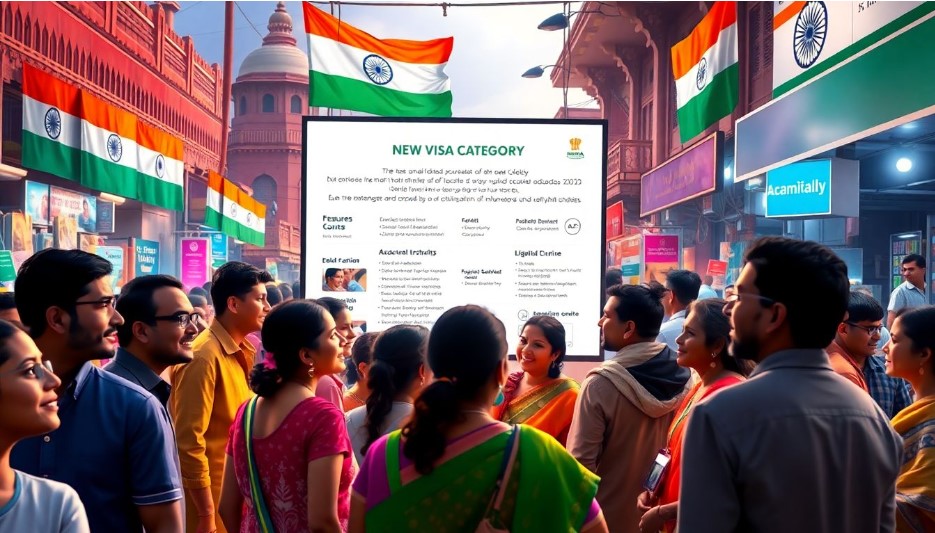Imagine being a brilliant software engineer eager to contribute your skills to India’s booming tech industry, but you are stuck dealing with piles of confusing visa paperwork. Or consider researchers wanting to collaborate with Indian scientists. The old visa rules made things a real headache. But now, there’s good news about Indian e visa document requirements.
India has just introduced a brand India launches new visa category. This change promises to make life much easier for foreign professionals and boost the Indian economy. This article will explore the exciting details of this new visa. We will examine the benefits, who can apply, the steps for application, and the overall impact on both professionals and India.
Understanding the Need for a New Visa Category
India’s visa system needed an update. It had to keep up with the country’s growth and goals. The previous options just weren’t cutting it. This new visa aims to solve common problems and fuel India’s progress.
Existing Visa Challenges
Existing visas came with problems. Processing times could be super slow. There were many limits on what you could do while in India. Visas didn’t last long enough, either. These issues stopped many talented people from coming to India. Software developers, engineers, and business owners all found it difficult to navigate the old system.
The Economic Rationale
India wants to attract more investment. It also wants to promote specific industries and share knowledge. A new visa makes all that easier. The government hopes it will bring in experts and boost economic growth. This visa can also attract global talent to improve India’s competitive edge.
Target Beneficiaries
The new visa mainly targets professionals in tech, engineering, finance, and academia. Scientists, researchers, and consultants can benefit, too. People from all over the world are welcome to apply. This initiative focuses on those who can contribute to India’s growth.
Key Features and Benefits of the New Professional Visa
The new professional visa comes with many perks. It is designed to be flexible and user-friendly. Let’s look at what makes it so appealing.
Visa Validity and Extensions
The visa is usually valid for five years. This gives people plenty of time to work and live in India. You can also extend it if you meet certain conditions. The government understands that projects take time, and the visa reflects that.
Permitted Activities
This visa lets you do a lot! You can work for an Indian company. You can conduct research or attend conferences. Starting a business is also an option. The visa is designed to support a wide range of professional activities.
Advantages Over Existing Options
Compared to other visas, this one is much faster to get. It also allows for more activities. The eligibility rules are clear, too. This visa is a big improvement over the older, more restrictive options. It saves time and opens more doors.
Eligibility Requirements and Application Process
Applying to India introduces a new category of visa for the visa might seem hard. But with the right info, it is manageable. Here’s a guide to help you.
Detailed Eligibility Criteria
To apply, you need a college degree or equivalent experience. Work experience in your field is crucial, too. You will need to show that you have enough money to support yourself. Certain nationalities may have specific rules. Make sure you meet all requirements before applying.
Required Documentation
You will need several documents. This includes your passport, degree certificates, and employment letters. Bank statements are needed to prove your finances. You might also need a police clearance certificate. It is smart to have all your documents ready before you start your application.
Step-by-Step Application Guide
- Go to the Indian government’s online visa portal.
- Fill out the application form carefully.
- Upload all required documents.
- Pay the visa fee.
- Schedule an interview if needed.
Follow these steps, and you will be on your way.
Impact on Tech Professionals and the Indian Economy
This new visa can change things for both tech professionals and India’s economy. The opportunities are huge. Let’s see how.
Opportunities for Tech Professionals
The visa opens doors for new jobs and business chances. You can share your knowledge and learn from Indian experts. This visa can help you grow your career and make a real difference.
Foreign Investment and Economic Growth
More foreign talent means more investment. This can lead to economic growth and new innovations. The visa makes India more attractive to global companies. It also boosts India’s reputation as a tech hub.
Potential Challenges and Mitigation Strategies
There might be some challenges. Bureaucracy can be slow. It might take time to adjust to a new culture. To tackle these issues, get help from immigration experts. Learn about Indian customs, too. With good preparation, you can overcome these hurdles.
Actionable Tips for Potential Applicants
Want to increase your chances of getting the visa? Here’s some practical advice.
Preparing Your Application
Highlight your skills and experience in your application. Gather all the necessary documents in advance. Write a strong cover letter explaining why you want to work in India. A well-prepared application shows you are serious.
Navigating the Application Process
Keep track of deadlines and follow up on your application. If you face delays, contact the visa office for updates. Authorized immigration consultants can provide valuable assistance. Be patient and persistent.
Maximizing Opportunities in India
Build connections by networking with other professionals. Find suitable housing before you arrive. Take time to understand local customs and traditions. Embrace the culture, and you’ll have a great experience.
Conclusion
India’s new visa category is a positive step. It makes it easier for professionals to work and live in India. This will boost India’s economy and create new opportunities. If you are thinking about working in India, now is the time to explore this option. Take advantage of this chance to grow your career and contribute to India’s future.





